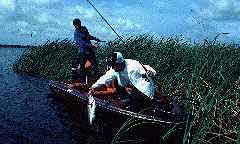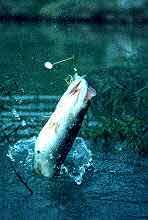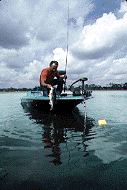|
South Florida's Big Lake
Okeechobee is one place where the bass are always biting!
by Larry Larsen I pulled the bait free of the
stalk and watched it plummet quickly out of sight below the bush. The line twitched and then jumped to the side as a bass bolted from the cover. My hook set was late but adequate. Reeling furiously, I
caught up with the hard charging bass and soon lipped it.
|
 |
The two-pounder was freed of its worm hook and released. Two casts later, my partner took its twin
as we circled the small stand of pepper grass and other vegetation that had grown up around a brushy area on Lake Okeechobee. Seven bass from the irregular 400 square foot
weed clog was the reward for our dedication to the spot.
Our Texas-rigged worms were mostly gobbled up onto fall by the active spring bass. None of those largemouth or the other
10 we ferreted from another five similar spots were large - three and one-half pounds max. Seven inch plastic wigglers in moccasin, pumpkinseed and brown hues were productive for
the smaller bass, but we weren't able to fool any giants on this day. With the lake so full of largemouth between one and four pounds, that's understandable, though.
Worming the "hayfields" of the huge Lake Okeechobee is usually a productive spring pattern for
largemouth bass, and often, one of six to 10 pounds is the "anchor" to a significant" numbers" catch. Although bass in the lake seldom exceed 12 pounds, there are millions inhabiting the watery "Bass
Factory" in southern Florida. Only the sheer size of the "Big O", as it's called by many, prevents it from becoming too crowded with bass boats.
Pollution problems originating from agricultural practices and watershed development have been a
major concern to the lake's fishery biologists for many years. Excessive nutrients discharged into this system stimulated a massive bloom of blue-green algae during 1986 and resulted in low oxygen
conditions and widely publicized fish kills. Fortunately, the bass fishery was relatively unaffected, but the need to monitor and prevent potentially damaging problems is more critical than ever, according to the
Game and Fresh Water Fish Commission.
|
 |
In 1981, the most severe drought on record lowered the lake and concentrated the bass population
into deeper areas away from the shoreline. Water had receded several miles from the normal shoreline, leaving much of the vegetated lake
bottom baking in the sun. Rains finally came and the lake started to refill. Then, vegetation blossomed and the low pH rose again to optimal levels.
A severe drought in 1990 also lowered the lake and many areas of the lake were dry. The lake slowly started to refill, and minnow populations exploded. With the new water levels have come improved access and
better bass fishing.
Navigation at normal water levels is generally hazard free. At low water conditions, that's another story. Many lower units are damaged on
submerged rocky areas. Also, because it is shallow, Okeechobee can "blow up" in a hurry. White caps can cause concern for those having to
run in such conditions. Hundreds of boat trails crisscrossing vegetated areas offer an escape from wind-whipped open water when caught in a sudden thunderstorm. Some areas of aquatic growth are so thick that
they are impassable. As a result, weedless baits and top water fare are the most efficient over most of the lake.
|
 |
As I once again proved while researching my book, "Guide to South Florida Bass Waters," not all of
bass are buried in vegetation. I was on the south Florida lake at daybreak searching for early schooling largemouth bass. After an hour's plugging of the sawgrass my
livewell was still dry. Had two catfishermen not run their net nearby, the action might not have picked up.
I watched as a wooden, commercial rig pulled into the grassy cove. The men threw out a grappling
anchor to snag the heavy rope that their net was tied with and soon pulled up a wire net with several fish flopping within. The cat fishermen extracted the selected prey and dumped the remaining fish and other
marine life overboard. They rebaited their net and tossed it into the depths, moving on down the cove toward the next net set.
|
The bass-laden waters of Okeechobee are
surrounded by dikes and have holes cut in them so that the water movement will not be inhibited. The farmland is rich in nutrients, and the dense vegetation is extremely attractive to forage. |
Quickly, I moved to the newly chummed area via the high-speed trolling motor. A 3 1/2 pound
largemouth choked on my tail spinner lure and hit the cove's surface. I pulled him over the gunwale after his third leap skyward. A second quick cast resulted in
another strike. I soon landed a twin of the first and both were released to grow up.
I continued to work the area where the net had been baited and where the
majority of its contents had been dispersed in the water. My catch over the following hour was seven largemouth schoolers which averaged a solid three
pounds each. The fish never did get active on the surface, but crank baits and tail spinners accounted for some exciting early action on open water just off the weedline.
A pH meter can help you locate bass anywhere on the lake, according to guide Walt Reynolds. Largemouth prefer a 7.4 to 7.9 range, but if no waters
offer those readings, then fish the areas with pH values closest to the 'optimal' reading. In the more open water, schools of bass and/or their forage can be
spotted on a graph, once the optimal area has been determined from the pH levels.
Most of the lake's bottom away from the vegetation is flat and structureless, but there are several
areas where channels have been dredged for navigation purposes. You can check for them around the post-mounted markers with sonar. Other rocky reefs and shoals exist well offshore. Pay particular
attention to the areas where the secondary canals enter the big lake.Cuts, Canals & Catches
|
 |
When the winds blow on the big lake, much of the fishing moves to sheltered waters, but the action
doesn't stop. Canals, cuts and boat trails through the dikes, islands and dense jungle-like vegetation are productive to many. Hundreds of miles of the man-made
waterways lie around the perimeter of the big lake.
The 100-yard wide Rim Canal with stands of tall trees protects anglers from winds
and offers excellent fishing. The canal around the entire lake was the product of a massive 1930's flood control project. The 12-mile long canal on the northeast shore
provides great bassin', as does the northwest section. Both have an irregular shoreline, and the canal portion paralleling the north shoreline also provides access to man-made
feeder canals. The feeder canals there have boat docks and seawalls that concentrate bass.
|
 |
The rim canal from Moore Haven to Belle Glade has primarily shoreline cover and heavy boat traffic
during the weekends. When it was dug, irregular bottom was created, and as a result, some small ditches and depressions on the bottom can be viewed
with a sonar unit. Fish the canal ledges which occur about 15 feet off the bank for bass action. Many of the secondary canals that link with the Rim
Canal are 16 feet deep under normal water conditions. Uncle Joe's Cut (Mayaca Cut), Harney Pond Canal, Indian Prairie Canal and Taylor Creek are all productive bass spots.
Largemouth are also found beneath the bridges that span the canals leading into the lake. The running water around locks on some canals offer
depth and a fresh constant supply of food, such as minnows and grass shrimp. Watch for moving water and corresponding currents around cuts and
canal entrances. The canal waters are usually fairly clear with abundant vegetation along the shoreline.
A twitched surface lure, like the Luhr-Jensen Jerkin' Sam, will often attract
big bass from the canal cover edges. The wooden topwater plug with spinner aft is productive for largemouth around any cover on this lake. Several other techniques work on the
"Big O" bass, so it's not difficult to catch a few most any day.
Editor's Note: This article is a partial excerpt from the book,
"South Florida Bass Waters". For
complete information on all the waters in the southern half of the Sunshine State, check out the book. Click if you want help with lodging or flights. |
|

